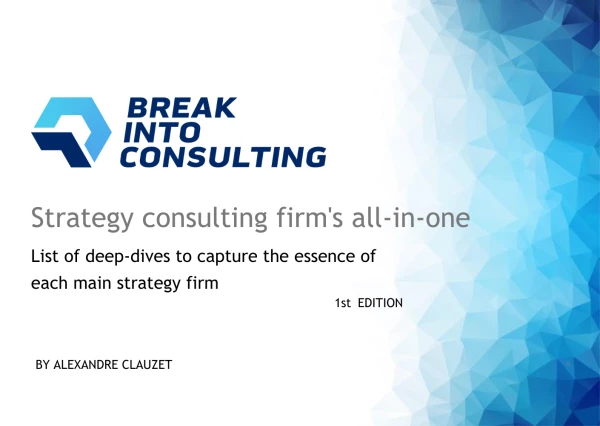I often get feedback that I need to involve the interviewer to solve the case. I am unsure what that actually means and how to go about doing it. Any examples will be highly appreciated.
How to involve your interviewer in solving the case?


This is a great question. Involving your interviewer is a way of ensuring you create a “conversation” dynamic, as opposed to a rigid question-and-answer dynamic. Think of it as cracking the case alongside the interviewer, with you in the lead - but not doing it solo. It means testing your answers and initial insights with your interviewer, asking for clarifications, and bringing them into the process of what you're doing. Here is an example of how you can do this in your case interview:
Bringing your interviewer in during the initial case structuring: After you receive the case information from your interviewer, take a moment to yourself to process the information, then repeat back the logic in an interactive way.
For example, you can say, “So our client, who manufactures packaging supplies, has seen X% decline in profitability over the past 5 years. Since profit is driven by revenue over cost, there are two reasons this could be happening: either our revenues are declining or our costs are increasing. I'd like to take a look at external and internal drivers of revenue and cost so we can figure out what's shifting our client's profitability. How does that sound?”
A few other examples of involving your interviewer:
- Aligning on your case approach: “I'd like to start by looking at what's driving our revenue. Are you okay with that approach or would you like to start elsewhere?”
- Asking for further information: “Let's begin first with the revenue drivers - how many people are buying the packaging supplies, and at what price they're buying them at. Do you have any information on these?”
- Testing your initial insights: “From the data shown, it seems our client's cost is disproportionately higher than the competitors, and it seems to be X component of the manufacturing process that is driving it. I'd like to focus on this component - anything else from the data I should take a look at?”

Hi there,
Q: I often get feedback that I need to involve the interviewer to solve the case. I am unsure what that actually means and how to go about doing it.
The question is a bit vague, as there is no context in which part of the case this is happening.
Most likely it means you are:
- Not aligning with the interviewer on what you would like to do and thought process and/or
- Not driving the case
Option 1: Aligning with the interviewer
Here you have to present to the interviewer what you want to do, so that you are both aligned on the process you want to follow. For example, for a math question you may say:
- “In order to solve this problem I think we should first find X, then subtract Y and finally we could multiply by Z as this will lead to ABC. As I have all the numbers, if ok with you I can now move to calculate the savings”
Option 2: Driving the case
Here you have to move to the next steps, explaining your hypothesis and asking a question to the interviewer on additional information needed to solve the case. You may also align with the interviewer on whether they prefer you continue on a particular area, as mentioned by Afreen. For example, after a graph analysis you may say:
- “After analyzing the graph, my hypothesis is that the problem is related to the cost of raw material. To check if that’s correct, I think it makes sense to review in detail the cost components. Do we have any information on how costs changed in the last year?”
For additional insights, I would recommend to add an example of the part of the case where you get this feedback as this would help to provide a more tailored answer.
Best,
Francesco

As Afreen suggested, the purpose of this is to get you to be more involved and conversational in your approach to change the dynamic from a traditional (stuffy) interview to that of a conversation around an interesting case study that you are both solving together.
For interviewer led cases (McKinsey) it would mean the following
- Summarizing the prompt and looking to the interviewer for confirmation and any missing relevant information
- Asking clarifying questions upfront
- Involving the interviewer in the setup of an answer (e.g., aligning with them on the approach to your quant answer before going ahead to solve the problem)
- Providing recommendations on next steps at the end of each question as opposed to stopping at the answer
These are some of the small things you can do to change the dynamic of how you approach interviewer led cases.
Best,
Udayan

Hi there,
This is all about “showing your thinking”!
So, things like “Ok, so the major insight I'm seeing here is x. That means we need to either a or b.”
Or “I'm thinking about this problem in the following way”
Or “Ok, let me just take a step back. We've done x and y, and we know we ultimately need to solve z problem.”
As part of my offering I do have 2 live case videos where I solve a case and you can watch me do so (1 case I knew beforehand, the other I did not). Feel free to reach out if interested to see how to involve the interviewer!
Case Reading: https://www.preplounge.com/en/articles/how-to-shift-your-mindset-to-ace-the-case

Dear candidate,
everyone has their style, but important things are,
a) when you answer questions try not to stall too much, rather if that happens, try to describe verbally what you are thinking and guide them through your thinking process.
b) agree approaches or next steps with them as you go through the case, for example when you got new information and you conclude what the next steps could be, get an ok from them, or when you finalized your approach, get an ok
c) ask them questions throughout for example as you search for information
Best regards

Hello!
That is indeed a fundamental point, particularly during the math part -where most of the mistakes are made, and many times can be avoided if involving correctly the interviewer.
For instance, for the math part:
Once you have a calculation, proof check it in a smart way with the interviewer (e.g., taking into consideration all the mentioned costs, it sums up to 5.5 million euros. Is this number in line with what the client was expecting, or is there anything else we should take into consideration before proceeding?"
Hope it helps!
Cheers,
Clara












